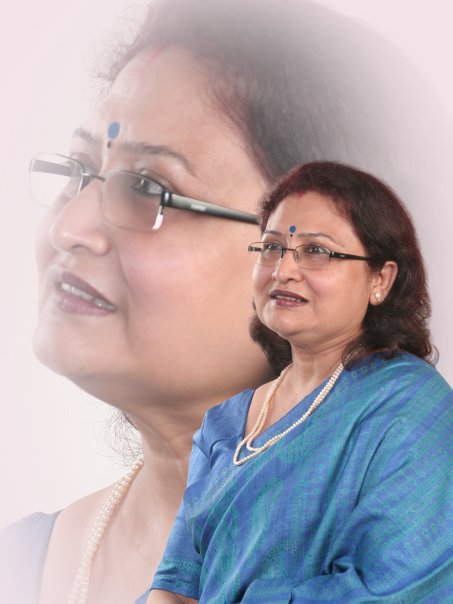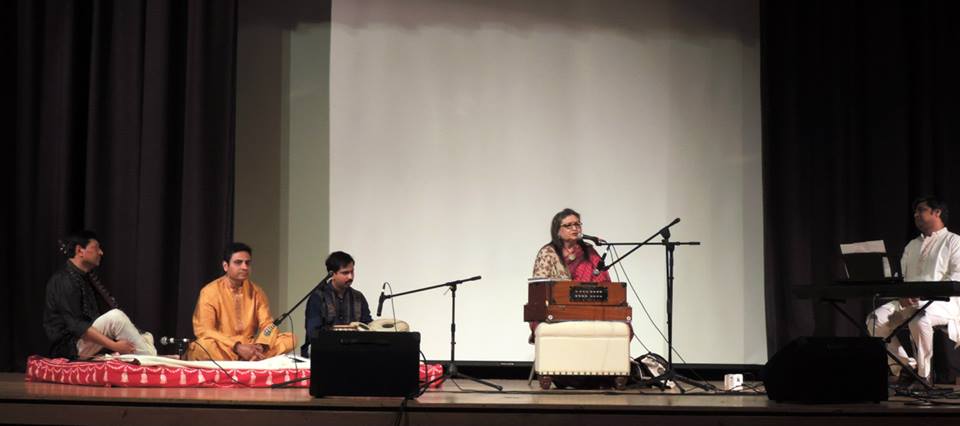Contribute
| In Conversation With Renowned Rabindrasangeet Singer Pramita Mallick |
Sreemoti Mukerjee-Roy
06/03/2014
Renowned Rabindrasangeet singer Pramita Mallick recently performed in Boston. Hosted by BNE (Bengalees of New England), lovers of Rabindranath Tagore’s songs enjoyed “Ananda Sandhya,†an evening of exquisite songs and narration. A lovely surprise was a “ (NidhuBabur) tappa†and a “Brahmo Sangeet.†Ms. Mallick sang a variety of songs, each one selected with care that showcased the wide range and style of Tagore’s creations. Each rendition was introduced with a brief history and its context. A well-sung Rabindrasangeet is a perfect harmony of music, melody, beats, words, pronunciation, emotion, and interpretation. With her rich voice, mastery of the music, her deep understanding of the genre, and her performance, Ms. Mallick re-created the quintessential “Rabindrasandhya.†Born and brought up in Santiniketan, the abode of Tagore’s vision, intellectualism, and creative genius, Ms. Mallick grew up with a deep appreciation of Tagore and all things Tagore. She trained under Tagore’s direct disciple Santidev Ghosh. She studied further under Kanika Bandopadhyay, Nilima Sen, Bishwajit Ray, Subinoy Roy, Suchitra Mitra, and Subhash Chowdhury, all great musicians and scholars of Rabindrasangeet. She continues the Tagorean tradition of scholar-performer-teacher inculcating in her students at her school Baikali, Kolkata a life-long relationship with Rabindrasangeet. Considered an authority on Rabindarsangeet by both the Governments of India and West Bengal, she serves them in several capacities as a global cultural ambassador and advisor, to spread Tagore’s thoughts and sets benchmarks for the arts and culture. As a Rabindrasangeet Expert with the Ministry of Culture, Govt. of India, Ms. Mallick oversees the cultural scholarship program. She is an empaneled artiste of the ICCR, Ministry of External Affairs, and an emissary for for Tagore’s works and philosophy abroad. In her native state of Paschim Bangla, she is a member of the advisory committee of the West Bengal State Music Academy directing the Academy’s activities. Lokvani had an opportunity to talk with Ms. Mallick about her art, the evolution of Rabindrasangeet, and where it is headed. In spite of the late hour, Ms. Mallick graciously engaged with us in the conversation. Lokvani: That was a wonderful performance! And thank you for giving us this time. We promise to be quick. Mallick: I am glad you enjoyed it and thank you for coming. I know how difficult it can be to attend a late evening performance. I am happy to talk to Lokvani. Lokvani: Although most people know of you as a Rabindrasangeet singer, you also regaled us with songs from the “Tappa†and “Brahmo Sangeet†genres, which leads us to think that you have specialized in all three styles. Why is it then we know of you as an exponent of only Tagore songs? Mallick: I am primarily a Rabindrasangeet singer – at least, I consider myself as such, although I trained in many types of music. Tagore himself composed many songs based on the “tappa†style and created many songs in the “Brahmo Sangeet†category. So it was a natural progression of the learning process to embrace the different styles and forms that make up the Tagorean repertoire. Lokvani: Can you tell us little about your view of Rabindrasangeet’s place in today’s society with its multivarious cultural exposure? Mallick: Rabindranath Tagore has a unique and strong presence in the Bengali culture and mind. He was a giant who continues to influence Bengali literature, arts, and intellectual pursuits. In many ways we have not been able to come out of the shadow of Tagore. We enjoy thriving under his influence. The downside of this is the “popularization†of Tagore’s songs. “Rabindrasangeet Schools†have mushroomed allowing easy learning opportunity to more but often compromising musical integrity. I am all for experiments if it adds to the spirit of Tagore's songs, but very much against meaningless music arrangements which destroy the soul of a song. These mislead listeners .....these people feel by being "modern" they are popularizing Tagore and keeping him alive. The current trends, orchestra instead of “esraj,†made for television gender-based competitions, to name a few, are vast deviations from what Tagore envisioned, and begs the questions – where is all this headed? Lokvani: Do you see this to be the future? This move away from the traditional or do you see the pendulum swinging back? Mallick: One can’t say with any surety that the new trends will continue, or for how long, if at all. Evolution goes through many phases, some good, some not so great. The good news is that there are still some who maintain the purist tradition and there is an audience that demands this type of purity. The size of the audience may have shrunk but there is a still a strong demand. Lokvani: Do you see the Tagore dance form also being impacted by the current trends? I can’t speak with as much authority on the dance form as I can for Rabindrasangeet. However, I have noticed the changes in the costume these days made out of very shiny material and sequins – a distinct departure from Tagore’s days. The hope is that the pendulum will swing back. While cultural evolution is a natural progression and inevitable, one must be careful of the changes and ensure that the original meaning is not fundamentally altered.
You may also access this article through our web-site http://www.lokvani.com/

